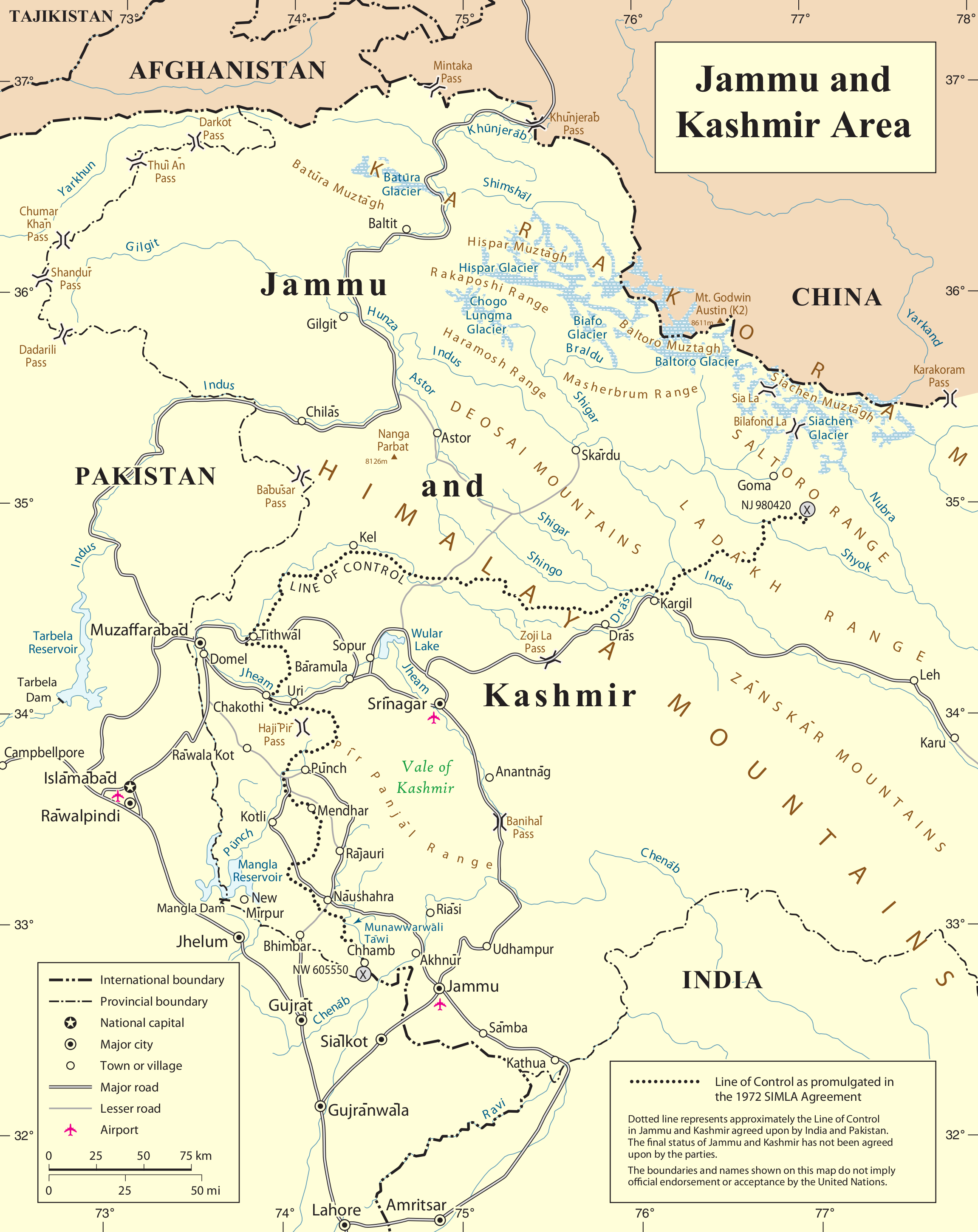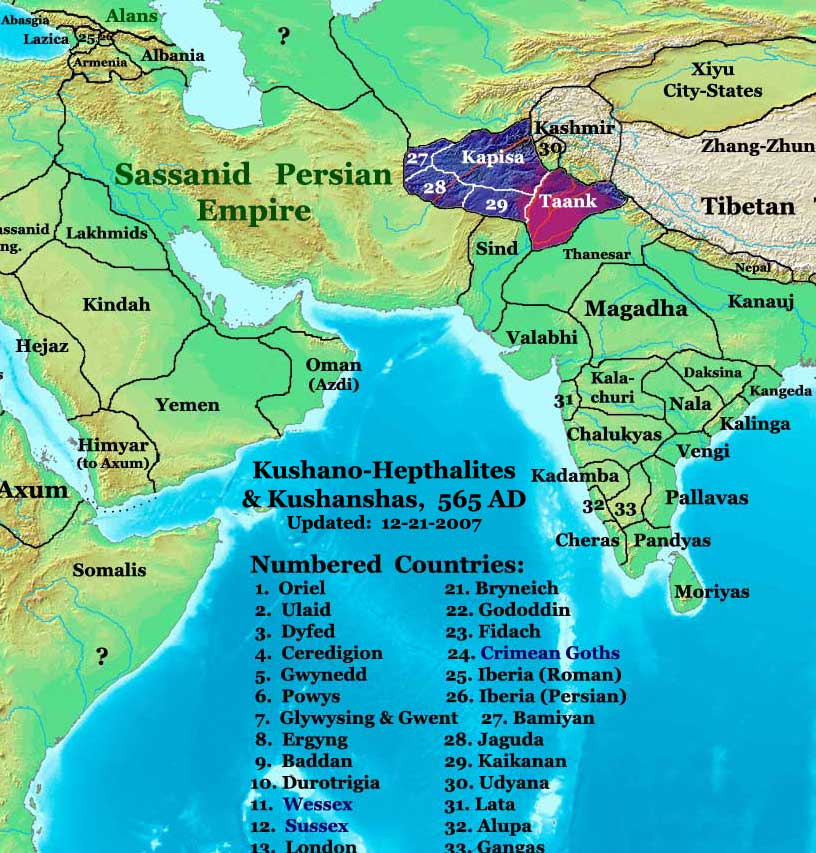|
Gilgit Agency
The Gilgit Agency ( ur, ) was an agency of the British Indian Empire consisting of the subsidiary states of the princely state of Jammu and Kashmir at its northern periphery, mainly with the objective of strengthening these territories against Russian encroachment. The subsidiary states included Hunza, Nagar and other states in the present day districts of Gupis-Yasin, Ghizer, Darel, Tangir and Diamer. The agency headquarters was based in the town of Gilgit, which was itself under the direct administration of the Maharaja of Jammu and Kashmir. An Officer on Special Duty was established in 1877 in the town of Gilgit, upgraded to a permanent Political Agent in 1889. In 1935, the Gilgit tehsil of the princely state was leased from the Maharaja of Jammu and Kashmir, which also came under the administration of the Political Agent. The Astore tehsil continued to be under the Maharaja's administration. In July 1947, shortly before the independence of India and Pakistan, the Gilg ... [...More Info...] [...Related Items...] OR: [Wikipedia] [Google] [Baidu] |
Indian Empire
The British Raj (; from Hindi ''rāj'': kingdom, realm, state, or empire) was the rule of the British Crown on the Indian subcontinent; * * it is also called Crown rule in India, * * * * or Direct rule in India, * Quote: "Mill, who was himself employed by the British East India company from the age of seventeen until the British government assumed direct rule over India in 1858." * * and lasted from 1858 to 1947. * * The region under British control was commonly called India in contemporaneous usage and included areas directly administered by the United Kingdom, which were collectively called British India, and areas ruled by indigenous rulers, but under British paramountcy, called the princely states. The region was sometimes called the Indian Empire, though not officially. As ''India'', it was a founding member of the League of Nations, a participating nation in the Summer Olympics in 1900, 1920, 1928, 1932, and 1936, and a founding member of the United Nations in Sa ... [...More Info...] [...Related Items...] OR: [Wikipedia] [Google] [Baidu] |
Astore District
Astore District ( ur, ) is one of the 14 districts of the Pakistani-administered territory of Gilgit−Baltistan. Its administrative headquarters are located at Eidgah in the Astore Valley. The Astore District is bounded by Gilgit District to the north, Roundu District to the northeast, Skardu District to the east, Kharmang District to the southeast, Diamer District to the west, the Neelum District of Azad Jammu and Kashmir to the southwest, and the Bandipore District of Indian-administered Jammu and Kashmir to the south. Astore Valley The Astore Valley has an area of 5,092 km² and is at an altitude of . The valley has approximately of glacier cover. The nearest glacier after entering the valley is the Harcho Glacier, and the most accessible glacier is the Siachen Glacier. Accessibility Eidgah is connected to Gilgit, which is well connected by air with Islamabad and by road with Peshawar, Swat, Islamabad-Rawalpindi, Chitral, and Skardu. There are two ways o ... [...More Info...] [...Related Items...] OR: [Wikipedia] [Google] [Baidu] |
Hunza State
Hunza (, ur, ), also known as Kanjut (; ), was a principality and then later a princely state in a subsidiary alliance with British India from 1892 to August 1947, for three months was unaligned, and then from November 1947 until 1974 was a princely state of Pakistan. Hunza covered territory now forming the northernmost part of Gilgit-Baltistan, Pakistan. The princely state bordered the Gilgit Agency to the south, the former princely state of Nagar to the east, Xinjiang, China to the northeast and Afghanistan to the northwest. The state capital was Baltit (also known as Karimabad). The princely state of Hunza now is the Hunza District in Pakistan. History Hunza was an independent principality for centuries. It was ruled by the Mirs of Hunza, who took the title of Thum. The Hunzai's were tributaries and allies to China, acknowledging China as suzerain since 1760 or 1761. Hunza rulers claimed descent from Alexander the Great, and viewed themselves and the Emperor ... [...More Info...] [...Related Items...] OR: [Wikipedia] [Google] [Baidu] |
Ishkoman Valley
The Ishkoman ( ur, ) valley lies in the north of Ghizer District in Gilgit-Baltistan, Pakistan, bordering Afghanistan and the Pamir Wakhan Corridor The Wakhan Corridor ( ps, واخان دهلېز, translit=wāxān dahléz, fa, دالان واخان, translit=dâlân vâxân) is a narrow strip of territory in Badakhshan Province of Afghanistan, extending to Xinjiang in China and separat .... Its altitude ranges from 7,000 to 12,000 feet (2,100 to 3,700 m) above sea level. See also * Pakkora References {{reflist Ghizer District Valleys of Gilgit-Baltistan Regions of Pakistan ... [...More Info...] [...Related Items...] OR: [Wikipedia] [Google] [Baidu] |
Punial State
Punial State in Pakistan was formerly a princely state (under the British it was a "Special Political District" of the Gilgit Agency and not a Princely State) in the northwest part of the Northern Areas which existed until 1974. The state bordered the Gilgit Tehsil to the south, the former princely state of Yasin to the west, Ishkoman to the north and Afghanistan (Wakhan Corridor) to the northwest. The State Had Two Capitals while ruled by two Islamic dynasties from different religious background which included the Katur Dynasty (Sunni) and Aqa Shah Dynasty (Ismaili). The state capital was the town of Sher Qila until 1889, it was soon replaced by the town of Gahkuch , after Aqa Shah Ruler His Highness Aqa Sultan Akbar Shah expanded the States boundaries by forming a small military relief force named the Punial Levi's in 1889. The area of Punial now forms the above named tehsil of Ghizer District. Punial was an independent principality for several centuries. The British g ... [...More Info...] [...Related Items...] OR: [Wikipedia] [Google] [Baidu] |
Yasin State
Yasin ( ur, ''Yāsīn''), also known as Babaye-i-Yasen () or Worshigum ( khw, ''Worśigūm''), is a high mountain valley in the Hindu Kush mountains, in the northern part of Gupis-Yasin District in the territory of Gilgit-Baltistan, Pakistan. The valley is about from city of Gilgit (the capital of Gilgit Baltistan). The Yasin Tehsil is situated on its territory. History Although sparsely populated, Yasin was of strategic importance because it leads to a high mountain pass to Yarkhun Valley and then to Broghil Pass in Chitral, connecting with the Wakhan Corridor of Afghanistan and Tajikistan. Early period Yasin valley was administrative centre of Worshigum which remained under the suzerainty of Mehtars who emerged from Chitral. The Mehtars of Yasin were great warriors and fought against the Sikhs and the Dogras of Kashmir in Gilt agency. But more often, they fought with each other, intrigued and murdered each other. Eventually the British got tired of them and took con ... [...More Info...] [...Related Items...] OR: [Wikipedia] [Google] [Baidu] |
Koh-i-Ghizer
Golaghmuli Valley ( ur, وادی پھنڈر) or Koh-i-Ghizer ( ur, کوہ غذر) or Valley of Martyrs ( ur, وادی شہداء) or Shandur Valley ( ur, وادی شندور) is a high mountainous valley in the present day Gupis–Yasin District of Gilgit-Baltistan, Pakistan. Geography This valley is situated to the east of Chitral and north of Swat. Golaghmuli Valley is separated from the Chitral and Swat by high mountain passes. To reach Golaghmuli Valley, a person must take the Gilgit-Chitral road west from Gilgit, and then continue his journey straight by Gupis. After Gupis, one continues northwest to reach the Yasin Valley and the straight road goes to Golaghmuli Valley. History Golaghmuli Valley is a big part of Tehsil Phander, a new Tehsil of Ghizer District (now part of Gupis–Yasin District). It was formerly a part of Tehsil Gupis. In the government of PPP, it was decided to make Golaghmuli, a new Tehsil. But the government of PML (N) gave it the whole power of a Te ... [...More Info...] [...Related Items...] OR: [Wikipedia] [Google] [Baidu] |
Chilas
Chilas ( ur, ) is a city and is the divisional capital of Diamer District located in Gilgit-Baltistan, Pakistan, on the Indus River. It is part of the Silk Road connected by the Karakoram Highway and N-90 National Highway, which link it to Islamabad and Peshawar in the southwest, via Hazara and Malakand Divisions of Khyber Pakhtunkhwa. In the north, Chilas is connected to the Chinese cities of Tashkurgan and Kashgar in Xinjiang, via Gilgit, Aliabad, Sust, and the Khunjerab Pass. Chilas comes under Gilgit-Baltistan. It is the Headquarters of District Diamir.1(Pamir Times August 2, 2012.) The weather is hot and dry in the summer and dry and cold in the winter. It can be reached through the Karakoram highway and also from the Kaghan valley passing over the Babusar Pass. Chilas is situated on the left bank of the mighty Indus River. The beautiful fairy meadows and Nanga Parbat, the ninth highest peak in the world, is also located in Chilas Recently, Karakoram International ... [...More Info...] [...Related Items...] OR: [Wikipedia] [Google] [Baidu] |
Princely State
A princely state (also called native state or Indian state) was a nominally sovereign entity of the British Indian Empire that was not directly governed by the British, but rather by an Indian ruler under a form of indirect rule, subject to a subsidiary alliance and the suzerainty or paramountcy of the British crown. There were officially 565 princely states when India and Pakistan became independent in 1947, but the great majority had contracted with the viceroy to provide public services and tax collection. Only 21 had actual state governments, and only four were large ( Hyderabad State, Mysore State, Jammu and Kashmir State, and Baroda State). They acceded to one of the two new independent nations between 1947 and 1949. All the princes were eventually pensioned off. At the time of the British withdrawal, 565 princely states were officially recognised in the Indian subcontinent, apart from thousands of zamindari estates and jagirs. In 1947, princely states covered ... [...More Info...] [...Related Items...] OR: [Wikipedia] [Google] [Baidu] |
Gilgit-Baltistan Map With Tehsils Labelled
Gilgit-Baltistan (; ), formerly known as the Northern Areas, is a region administered by Pakistan as an administrative territory, and constituting the northern portion of the larger Kashmir region which has been the subject of a dispute between India and Pakistan since 1947, and between India and China from somewhat later.The application of the term "administered" to the various regions of Kashmir and a mention of the Kashmir dispute is supported by the tertiary sources (a) through (d), reflecting due weight in the coverage. Although "controlled" and "held" are also applied neutrally to the names of the disputants or to the regions administered by them, as evidenced in sources (e) through (g) below, "held" is also considered politicized usage, as is the term "occupied," (see (h) below): (a) (subscription required) Quote: "Kashmir, region of the northwestern Indian subcontinent ... has been the subject of dispute between India and Pakistan since the partition of the Ind ... [...More Info...] [...Related Items...] OR: [Wikipedia] [Google] [Baidu] |
Ladakh
Ladakh () is a region administered by India as a union territory which constitutes a part of the larger Kashmir region and has been the subject of dispute between India, Pakistan, and China since 1947. (subscription required) Quote: "Jammu and Kashmir, state of India, located in the northern part of the Indian subcontinent in the vicinity of the Karakoram and westernmost Himalayan mountain ranges. From 1947 to 2019, Ladakh was part of the Indian state of Jammu and Kashmir, which has been the subject of dispute between India, Pakistan, and China since the partition of the subcontinent in 1947." Quote: "Jammu and Kashmir: Territory in northwestern India, subject to a dispute between India and Pakistan. It has borders with Pakistan and China." Ladakh is bordered by the Tibet Autonomous Region to the east, the Indian state of Himachal Pradesh to the south, both the Indian-administered union territory of Jammu and Kashmir and the Pakistan-administered Gilgit-Baltistan to the wes ... [...More Info...] [...Related Items...] OR: [Wikipedia] [Google] [Baidu] |
Federally Administered Northern Areas
Gilgit-Baltistan (; ), formerly known as the Northern Areas, is a region administered by Pakistan as an administrative territory, and constituting the northern portion of the larger Kashmir region which has been the subject of a dispute between India and Pakistan since 1947, and between India and China from somewhat later.The application of the term "administered" to the various regions of Kashmir and a mention of the Kashmir dispute is supported by the tertiary sources (a) through (d), reflecting due weight in the coverage. Although "controlled" and "held" are also applied neutrally to the names of the disputants or to the regions administered by them, as evidenced in sources (e) through (g) below, "held" is also considered politicized usage, as is the term "occupied," (see (h) below): (a) (subscription required) Quote: "Kashmir, region of the northwestern Indian subcontinent ... has been the subject of dispute between India and Pakistan since the partition of the Ind ... [...More Info...] [...Related Items...] OR: [Wikipedia] [Google] [Baidu] |








